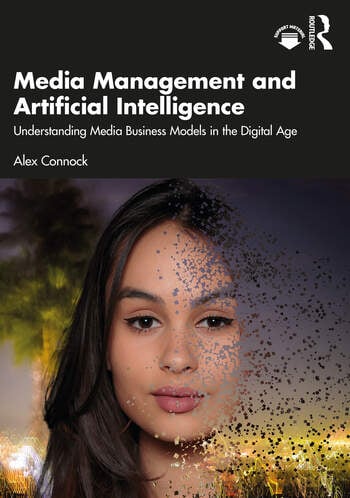Connock, A. (2022). Media Management and Artificial Intelligence Understanding Media Business Models in the Digital Age. Routledge. ISBN 9781032100944, 344 Pages 16 B/W Illustrations, Published November 18, 2022, by Routledge.
The recently published book authored by Alex Connock scrutinizes contemporary media business models in the context of Artificial Intelligence (AI) and corresponding digital transformations. The objective of this book, as set out by the author, is “to be a guide to contemporary media business models in the age of Artificial Intelligence”. To put it differently, this book aims to assess to what extent “AI is really the change agent of the media industry and will open incredible opportunities.” To present his argument, the author divides his research in four sections, which are principles, platforms, producers, and pioneers. These four sections are covered by 19 chapters, which seek to analyze segments of the media industry. The text explores these segments by means of a single value creation construct, from development through production, and distribution to monetization. This model will be revisited for each type of media, which ensures coherence among sections throughout the book. Within each segment, there are similar stories of radical change.

The first section is one of the most pertinent pieces of this text, which is titled “Principles: media business models and the basic tools of AI”. This section provides a clear statement of the framework used for media industry analysis, which is utilized in each succeeding chapter. This part is an introduction that elucidates the general principles of the four stages of the value creation model and tools of AI. The author takes on the enormous task of simplifying complicated terms. This includes defining key words, from different perspectives, such as ‘media’, and ‘AI’. Accordingly, “Media is not a solid space and Artificial Intelligence is not an agreed term either. Definitional imprecision notwithstanding, the media and AI are the twin recommendation engines of twenty-first century life.” Yet, despite the object's imprecision, its impact is perceptible. The AI industry has already expanded significantly and is growing at an accelerated rate. Furthermore, various use cases outlined as Artificial Intelligence are Machine Learning, which include supervised learning, reinforcement learning, unsupervised learning and self-supervised learning. Each of these domains serve as a fundamental tool in applying AI to many aspects of media development, production, and distribution.
The second section of this book discusses practical application by examining platforms, which he posits are the “engines of media distribution”. More specifically, the author examines platforms through games, social networks, streamers, broadcasters, and digital publishers. The initial chapter examines the multi-billion-dollar industry of gaming, which exists on AI-powered platforms that simultaneously host games powered by AI. The subsequent chapter on social media demonstrates how much influence these platforms have exerted in connecting users, while simultaneously embedding AI into its functionality. Building upon the influence of social media platforms, the author investigates the digital phenomena of streamers, which has established a novel media industry that is underwritten by innovative use of AI. Interestingly, the author’s examination of broadcasters demonstrates how these corporate entities are at risk due to the aforementioned platforms. As such, broadcasters are redirecting to video-on-demand to combat this shift. Finally, digital publishers—for example, news sites—are also implementing novel revenue models, which are somewhat like broadcasters. These tremendous shifts in media creation and consumption reveal a everchanging landscape that is tremendously influenced by the proliferation of AI.
The author devotes the third section of the book to producers. This portion of the book is divided into chapters that examine sub-genres of production, which include scripted, entertainment, factual, content marketing, creators, and music. It examines the businesses responsible for creating the content users engage with continually. This technologically driven shift is accompanied by a rapid globalization of the content footprint, which has been heavily influenced by dynamics of the entertainment industry. Meanwhile, the merger of distribution channels has deeply changed this formerly very traditional industry, which has rendered the boundaries between different types of content ever more unclear. Likewise, video content has emerged as a key marketing tool, as this tool is employed at an unprecedented scale. Furthermore, this section dedicates a chapter to address the role of creators by highlighting the emergence of a global and democratic model of media ownership, which allows a wider range of individuals to participate in the creation and distribution of content. It is worth noting that Connock endeavored to propose a definition of creativity, which was an already difficult undertaking that is compounded by the advent of AI creativity. The last chapter in this section focuses on the music industry. This formerly analog industry has been heavily scarred by the advent of digital technology, which includes a profound transformation of the entire business model that had formerly sustained it for decades. This industry is quickly attempting to catch up by re-inventing everything from the creative processes to monetization by integrating AI tools that optimize and facilitate novel streams of revenue.
The last section of the book focuses on pioneers, which addresses the novel and still emerging domains of podcasting, esports, and the metaverse. As these digital realms are still developing it is understandable why the author perceives these industries as pioneers, as the business patterns they establish now are likely to significantly shape the media industry in the forthcoming years. Although it was still a niche segment when this book was authored, podcasting has grown tremendously and is emerging as a digital content development factory, as well as one of the most creative sectors in media. Similar to podcasting, esports is still a burgeoning digital media business model that is growing rapidly. Interestingly, it has incorporated echoes of 20th-century media construct. Meanwhile, the Metaverse is still in a virtual stage, but is gaining momentum and attracting the attention of media industry. The examination of these novel avenues of media in the AI era reveal a future that faces many challenges and opportunities for media management, which require constant adaptation of strategies and approaches to leverage digital innovation.
This book marks a significant contribution to existing literature on media business models that are rapidly adapting for the digital age, particularly as it pertains to AI. Connock’s examination and perspective goes beyond classic treatments of this topic. First and foremost, it adopts a specific approach that sets it apart, which involves the four-stage media value creation model of development, production, distribution and monetization. Rather than confining itself to a narrow descriptive or normative focus, the book encompasses a broad spectrum of interdisciplinary approaches, which include media management and media business studies, along with—although to a lesser extent—celebrity studies and academic studies of film industry. This includes multiple case studies from Europe (France, The Netherlands, The UK, Denmark), Asia (India, South Korea, China), Africa (Nigeria, South Africa) and North America (The US). Despite the numerous and seemingly varied case studies, there remains a need for additional diversification as it pertains to cultural diversity, which may aid in better understanding a more cohesive global set of ideals. This is particularly true regarding the Middle East and North Africa (MENA) region. Despite this shortcoming, the book delves into creative entrepreneurship, revenue models, profit drivers, digital rights, emerging AI tools, as well as other areas of interest. The author combines both qualitative and quantitative techniques while examining the media industry from a myriad of perspectives, which provides a holistic understanding of media business models. This mixed methods approach provides the opportunity to substantiate information across various sources and media sectors, which enriches the analysis from multiple perspectives. More specifically, text comprises statistical data governing the use of quantitative approach, while qualitative is based primarily on first-hand interviews with industry players in the realms of digital publications, academic journals, original research studies, industry podcasts, and social media. In the same vein, the text draws inspiration from the works of prominent scholars and researchers who have explored the intersections between media management, media business, AI, and the digital transformation.
More importantly, it's not the kind of book you would casually pick up for leisurely reading, instead it’s a reference tool full of interesting facts and figures. Although it was published in 2022, despite the media business and technology rapidly developing, it still holds up and provides a myriad of interesting and important insight pertaining to the media business in the AI era. More specifically, this work maintains its exploratory relevance regarding the field of research and its various current and future manifestations. The final chapter examines the future of the media business and potential implications, which specifically examines media management trends in the age of AI and demonstrates how maintaining innovation is necessary for media companies to remain relevant and survive in a continuously developing technological landscape.
Since this reference offers many invaluable insights and suggestions for the future, it can act as one of the main references to examine and understand the media industry in the digital age. As an educational instrument, this is a suitable tool for teaching and learning. Moreover, the book provides digital resources—for example PowerPoint slides for each chapter and an Instructor’s Manual—that renders it a cutting-edge textbook for advanced undergraduate and postgraduates studying media management.
Throughout his book, Connock offers a framework to better understand and manage the workings of the modern media business in the age of AI. It’s undeniably evident that AI has profoundly impacted media production and distribution. Moreover, it should be acknowledged that the book proposes a specific scientific approach to understanding and analyzing the complex issue of AI in media and the resultant digital transformation. Ultimately, while the ethical drawbacks articulated in the book undoubtedly merit extended discussion, which includes call for exploration of North Africa and the Middle East could provide new avenues for research, the book is nonetheless a valuable resource.
 Arab Media & Society The Arab Media Hub
Arab Media & Society The Arab Media Hub





